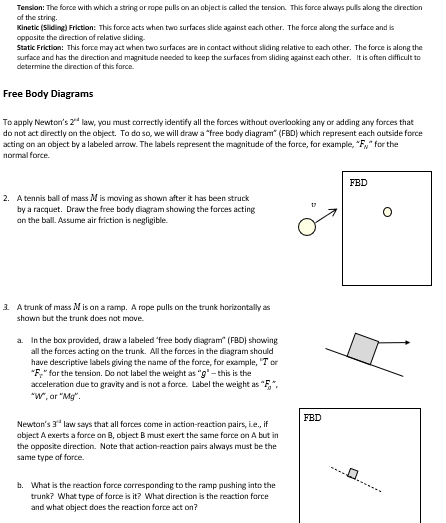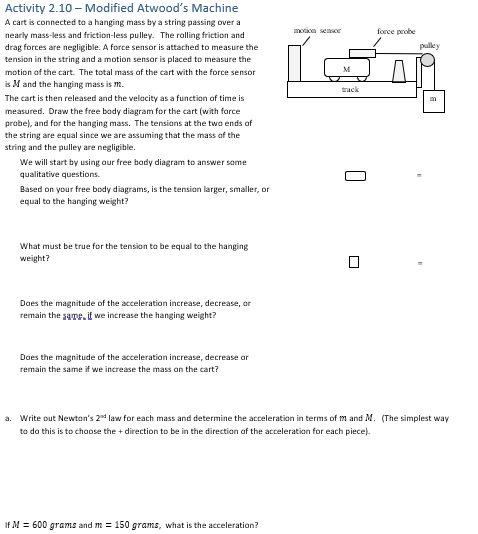3. A trunk of mass M is on a ramp. A rope pulls on the trunk horizontally as shown but the trunk does not move. a. In the box provided, draw a labeled 'free body diagram" (FBD) showing all the forces acting on the trunk. All the forces in the diagram should have descriptive labels giving the name of the force, for example, "Tor "F" for the tension. Do not label the weight as "g" - this is the acceleration due to gravity and is not a force. Label the weight as "F" "W", or "Mg". Newton's 3" law says that all forces come in action-reaction pairs, i.e., if object A exerts a force on B, object B must exert the same force on A but in the opposite direction. Note that action-reaction pairs always must be the of force FED
3. A trunk of mass M is on a ramp. A rope pulls on the trunk horizontally as shown but the trunk does not move. a. In the box provided, draw a labeled 'free body diagram" (FBD) showing all the forces acting on the trunk. All the forces in the diagram should have descriptive labels giving the name of the force, for example, "Tor "F" for the tension. Do not label the weight as "g" - this is the acceleration due to gravity and is not a force. Label the weight as "F" "W", or "Mg". Newton's 3" law says that all forces come in action-reaction pairs, i.e., if object A exerts a force on B, object B must exert the same force on A but in the opposite direction. Note that action-reaction pairs always must be the of force FED
Glencoe Physics: Principles and Problems, Student Edition
1st Edition
ISBN:9780078807213
Author:Paul W. Zitzewitz
Publisher:Paul W. Zitzewitz
Chapter5: Displacement And Force In Two Dimensions
Section: Chapter Questions
Problem 103A
Related questions
Question
pleae solve only number 3

Transcribed Image Text:Tension: The force with which a string or rope pulls on an object is called the tension. This force always pulls along the direction
of the string.
Kinetic (Sliding) Friction: This force acts when two surfaces slide against each other. The force along the surface and is
opposite the direction of relative sliding.
Static Friction: This force may act when two surfaces are in contact without sliding relative to each other. The force is along the
surface and has the direction and magnitude needed to keep the surfaces from sliding against each other. It is often difficult to
determine the direction of this force.
Free Body Diagrams
To apply Newton's 2 law, you must correctly identify all the forces without overlooking any or adding any forces that
do not act directly on the object. To do so, we will draw a "free body diagram" (FBD) which represent each outside force
acting on an object by a labeled arrow. The labels represent the magnitude of the force, for example, "F" for the
normal force.
2. A tennis ball of mass M is moving as shown after it has been struck
by a racquet. Draw the free body diagram showing the forces acting
on the ball. Assume air friction is negligible.
3. A trunk of mass Mis on a ramp. A rope pulls on the trunk horizontally as
shown but the trunk does not move.
a. In the box provided, draw a labeled "free body diagram" (FBD) showing
all the forces acting on the trunk. All the forces in the diagram should
have descriptive labels giving the name of the force, for example, "Tor
"F" for the tension. Do not label the weight as "g" - this is the
acceleration due to gravity and is not a force. Label the weight as "F",
"W", or "Mg".
Newton's 3" law says that all forces come in action-reaction pairs, i.e., if
object A exerts a force on B, object B must exert the same force on A but in
the opposite direction. Note that action-reaction pairs always must be the
same type of force.
b. What is the reaction force corresponding to the ramp pushing into the
trunk? What type of force is it? What direction is the reaction force
and what object does the reaction force act on?
FBD
FBD

Transcribed Image Text:Activity 2.10 - Modified Atwood's Machine
A cart is connected to a hanging mass by a string passing over a
nearly mass-less and friction-less pulley. The rolling friction and
drag forces are negligible. A force sensor is attached to measure the
tension in the string and a motion sensor is placed to measure the
motion of the cart. The total mass of the cart with the force sensor
is M and the hanging mass is m.
The cart is then released and the velocity as a function of time is
measured. Draw the free body diagram for the cart (with force
probe), and for the hanging mass. The tensions at the two ends of
the string are equal since we are assuming that the mass of the
string and the pulley are negligible.
We will start by using our free body diagram to answer some
qualitative questions.
Based on your free body diagrams, is the tension larger, smaller, or
equal to the hanging weight?
What must be true for the tension to be equal to the hanging
weight?
Does the magnitude of the acceleration increase, decrease, or
remain the same, if we increase the hanging weight?
Does the magnitude of the acceleration increase, decrease or
remain the same if we increase the mass on the cart?
motion sensor
If M = 600 grams and m= 150 grams, what is the acceleration?
M
track
force probe
pulley
a. Write out Newton's 2nd law for each mass and determine the acceleration in terms of m and M. (The simplest way
to do this is to choose the + direction to be in the direction of the acceleration for each piece).
Expert Solution
This question has been solved!
Explore an expertly crafted, step-by-step solution for a thorough understanding of key concepts.
This is a popular solution!
Trending now
This is a popular solution!
Step by step
Solved in 3 steps with 1 images

Knowledge Booster
Learn more about
Need a deep-dive on the concept behind this application? Look no further. Learn more about this topic, physics and related others by exploring similar questions and additional content below.Recommended textbooks for you

Glencoe Physics: Principles and Problems, Student…
Physics
ISBN:
9780078807213
Author:
Paul W. Zitzewitz
Publisher:
Glencoe/McGraw-Hill

University Physics Volume 1
Physics
ISBN:
9781938168277
Author:
William Moebs, Samuel J. Ling, Jeff Sanny
Publisher:
OpenStax - Rice University

College Physics
Physics
ISBN:
9781285737027
Author:
Raymond A. Serway, Chris Vuille
Publisher:
Cengage Learning

Glencoe Physics: Principles and Problems, Student…
Physics
ISBN:
9780078807213
Author:
Paul W. Zitzewitz
Publisher:
Glencoe/McGraw-Hill

University Physics Volume 1
Physics
ISBN:
9781938168277
Author:
William Moebs, Samuel J. Ling, Jeff Sanny
Publisher:
OpenStax - Rice University

College Physics
Physics
ISBN:
9781285737027
Author:
Raymond A. Serway, Chris Vuille
Publisher:
Cengage Learning

College Physics
Physics
ISBN:
9781305952300
Author:
Raymond A. Serway, Chris Vuille
Publisher:
Cengage Learning

Principles of Physics: A Calculus-Based Text
Physics
ISBN:
9781133104261
Author:
Raymond A. Serway, John W. Jewett
Publisher:
Cengage Learning

Physics for Scientists and Engineers, Technology …
Physics
ISBN:
9781305116399
Author:
Raymond A. Serway, John W. Jewett
Publisher:
Cengage Learning